The Rochester Review, University of Rochester, Rochester, New York, USA
![]()


SWING DANCING HITS THE CAMPUS
It would appear that swing and ballroom dancing are taking collegians across the country by storm. As one commentator on the college scene noted, the retro trend, along with a renewed interest in etiquette lessons, "is a kind of continuation of kids' soccer leagues--increasingly structured social action." And, in our health-minded, AIDS-conscious era, partnered dancing is both a great form of exercise and a way to connect with people safely.
Swing dancers at Rochester earlier this semester got some expert help on this new (to them) dance style from visiting instructor Joanna Mendl Shaw.
Shaw, at left above, is here introducing students to the concepts of "weight sensing"--the play of weight between dancers--and its relation to partnered dance forms.
As artist in residence with the University Dance Program, dancer-choreographer-educator Shaw was of course not just offering some tips on social dancing.
Shaw worked with students in choreographing and creating dances, and taught a range of classes from swing to visceral dance.
"I absolutely believe that these fundamental dance concepts can be applied to anything," says Shaw. "I help students build a fundamental skill base that gets them out of their heads and more in touch with their bodies."
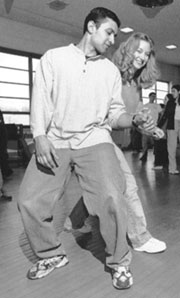
NEWLY NAMED WALLIS HALL HONORS FORMER PRESIDENT
At a memorial service for W. Allen Wallis following his death on October 12, President Jackson announced that the University's administration building has been named in honor of Rochester's former president and chancellor.
A world-renowned economist and statistician, President Wallis headed the University from 1962 to 1978 and was, in Jackson's words, "instrumental in its transformation to a national institution of the first rank."
The newly named Wallis Hall, located on Wilson Boulevard near the south entrance to the River Campus, was built in 1957.
"Allen Wallis was the first president whose entire time as CEO was spent in this building," Jackson noted.
It was the first to be built specifically to house the University's administration.
Early presidents had had offices in the University's main classroom building on the old Prince Street Campus. Later, until Wallis Hall was built, administrators occupied the former Watson mansion on that campus--with the president and treasurer housed in the front parlors, the p.r. and development staffs operating out of the maids' bedrooms, and the bursar holding forth in what were once the kitchens.
When it was opened in 1957, Wallis Hall accommodated the entire central administration. It no longer does so, but, as Jackson remarked, "it continues to house the University's central executive offices, and also is home to the admissions offices for the undergraduate program at the College."
FOUR APPOINTED TO PROFESSORSHIPS
Faculty members at the Simon School, School of Nursing, and the College have received appointments to named chairs.
At the Simon School, professor of finance and statistics William Schwert now holds the title of Distinguished University Professor. This designation is awarded by the University for significant accomplishment in scholarship coupled with outstanding service to the institution.
Schwert, whose current research deals with the market for corporate control and with stock market volatility, has been an editor of the Journal of Financial Economics since 1979 and its managing editor since 1995. He also holds editorships at The Journal of Finance and the Journal of Monetary Economics. He joined the Simon faculty in 1976.
A newly established professorship at the Simon School, the William H. Meckling Professorship in Business Administration, has been awarded to Ross Watts, professor of accounting and chair of the Simon Ph.D. program.
The new chair memorializes the late dean emeritus of the school, who, according to Simon dean Charles Plosser, was responsible, "more than any other single individual," for defining the character of the Simon School. Meckling was dean from 1964 until his retirement in 1983. The professorship honoring him is being endowed through contributions from current and former faculty, alumni, and friends.
Watts is founding editor (with colleague Jerold Zimmerman) of the Journal of Accounting and Economics and founding director of the electronic Accounting Research Network. Holder of an honorary professorship at City University in Hong Kong, Watts frequently presents seminars overseas. He received the 1996 University Award for Excellence in Graduate Teaching.
At the School of Nursing, the daughters of Ruth Miller Brody '42N, a former director of the school, and Bernard Brody '51M (MD), a former medical school faculty member, have established a professorship in their parents' honor.
Jane Kirschling, professor of nursing and associate dean for academic affairs at the school, has been named the Brody Chair's first incumbent. She serves in leadership roles on a number of local and national nursing and hospital boards and, following her interest in the role of nurses in end-of-life issues, is a member of the National Hospice Association Board.
Sponsors of the professorship are Sarah Epstein of Palo Alto, California, and Rachel Bandych of Fairport, New York.
Randall Calvert, an expert in American political institutions and a former chair of the Department of Political Science, has been appointed to fill the position of Don Alonzo Watson Professor in the College.
Calvert's academic specialties concentrate on legislative politics and the ways the structure of organizations affect political outcomes. He has written widely on aspects of policymaking and formal political theory and, among other professional activities, is co-editor of the journal Economics and Politics.
As a benefactor of the University, Don Alonzo Watson (1807-1892) endowed a professorship to acknowledge achievements in the study of political science and history. He was a successful Rochester businessman and co-founder with Hiram Sibley of Western Union.
Sit-in: Students concerned over diversity issues on campus staged a peaceful sit-in outside the president's office in February. About 200 undergraduates participated in the four-hour demonstration, which ended when students and administration put on record their mutually agreed-upon aims about several issues, principal among which were recruitment of minority students and faculty and enhancement of academic and cultural life for minorities. "A lot of what the students are asking for was already under way," said Robert Kraus, associate vice president for public relations, adding that ongoing meetings on the subject would improve communications on continuing progress. The demonstration was the first of its kind since the mid-1980s. (Photo by Max Schulte, Rochester Democrat and Chronicle.)
ROCHESTER HOSTS NATIONAL CONFERENCE FOR 2,000 UNDERGRADUATE RESEARCHERS
The 13th National Conference on Undergraduate Research, a forum that promotes academic achievement by undergraduates, was held on the River Campus over a three-day weekend this April.
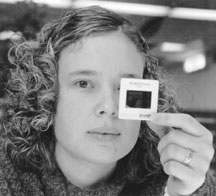
Anthropology major Kristin Dowell '99, who studies Native American pottery. She was one of more than 50 Rochester students making presentations at the conference.At this annual event, as many as 250 colleges and universities are represented by about 2,000 students who apply for the opportunity to present their scholarly and artistic research through oral presentations, performances, and poster sessions.
"Hosting this national conference is one indication of our commitment to undergraduate research," says Provost Charles Phelps. "Undergraduate research involves hands-on investigative work with faculty in every academic field in the University--in the humanities and the social sciences as well as the natural sciences. The concept of undergraduate research is woven completely into the fabric of our curriculum, for example, through our Quest courses for first-year students. It's a natural for us to host this conference."
Among the 58 Rochester undergraduates who made presentations is senior Kristin Dowell, an anthropology major from Westerville, Ohio, who over the last two years has been studying the ways Native American women in Arizona express themselves through making contemporary Pueblo pottery.
"Their pottery is a very direct way to connect with the heritage of their ancestors," she says. "It is also a form of personal expression, a challenge to the ways some people think Native American art ought to look."
As an outgrowth of this study, Dowell mounted an exhibit last year at the Cleveland Museum of Natural History and has lectured at the Rochester Academy of Science. She was recently one of 18 students nationwide to win a Beineke Brothers scholarship for graduate school.
Dowell's work on the study has been demanding, she admits. "I haven't had much free time over the last two years," she concedes. "But I wouldn't trade it for anything."
(Photo by Shawn Dowd, Rochester Democrat and Chronicle.)
UNDERGRADUATE CURRICULUM IN ELECTRONIC IMAGING CREATED
Many activities in everyday life involve electronic imaging in some way: CT or MRI scans at the hospital, digital map systems in new automobiles, snazzy World Wide Web pages that require long waits to squeeze into a computer, movies on digital video disk.
The field has exploded so rapidly and widely that universities are working to create a cohesive curriculum as freshmen already interested in such technologies arrive on their doorsteps.
Rochester undergraduates are now moving to the forefront of a national effort to improve education in electronic imaging, thanks to a $500,000 grant from the National Science Foundation.
The three-year grant is enabling faculty members from computer science, electrical and computer engineering, and optics to develop a comprehensive, well-rounded approach to imaging education, giving undergraduates a more comprehensive view of the rapidly growing field than is typically available to students.
University officials know of no other program that aims to teach undergraduates so broadly about electronic engineering.
Under the plan, five new courses are being added, nine others enhanced, two additional laboratories created, and undergraduate research opportunities developed.
One of the new classes, which began in January, brings to freshmen many of the tools that were new to graduate students and faculty members just a few years ago. The topics include the physics of color imaging, digital video and photography, computer vision and virtual reality, medical imaging, digital art and publishing, display technology, and image transmission.
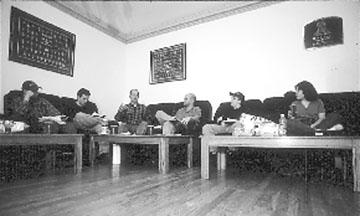
At home in the house: Political science professor Gerald Gamm (third from the left) believes that learning can--and should--be a moveable feast.Accordingly, he has moved his Wednesday afternoon seminar on urban politics into the Sigma Chi house, where everybody can relax and be comfortable. On chilly days, he says, the fireplace is crackling, "and the students can bring food."
Fraternity houses aren't Gamm's only unconventional venue. On an invitingly warm February day, for instance, he was observed cheerily lecturing to about a hundred students seated on the Quad steps surrounded by rapidly melting snowbanks.
"That was my class on Development of the American Party System," he confirmed later. "And we had a great time."
MAJOR GIFT CONTINUES LIBRARY 'RENAISSANCE'
Roger Friedlander '56 has what he calls "special memories" of Rush Rhees Library. His job as a student assistant reshelving books in its stacks afforded him extra money as
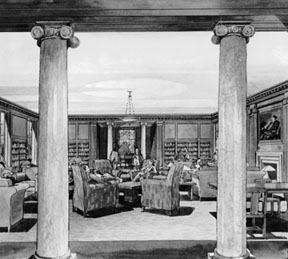
Rush Rhees Library's Welles=Brown Room as it will appear following its renovation this summer.
an undergraduate.And, he adds, "I also met my wife, Carolyn, there when she was using the library while home during her college break."
Now he has made a tangible repayment: a major gift to renovate two of the most public areas in the building--the Welles-Brown Room and the main lobby.
Described when the library first opened as "a club-like reading room" with all the "luxurious accoutrements of a private club," the Welles-Brown Room is named for two previous benefactors, Francis Welles, Class of 1875, and Charles Brown, Class of 1879, who underwrote the original accoutrements in 1930.
The renovation calls for replacement of furnishings, installation of new lighting and
a sound amplification system, and restaining of the walls.The main lobby, to be renamed the Roger B. Friedlander Lobby, also will be restored to its original elegance with improvements to the display cases, removal of the turnstile barriers, cleaning of the stone walls and chandelier, and installation of new grillwork.
Friedlander, a University trustee, is founder of Spectrum Office Products.
His is the second major gift to the "Rush Rhees Renaissance," a $15.5 million initiative to renovate most of the interior of the library over the next three to five years. A similar gift last year from Martin Messinger '49 made possible the restoration of the second-floor periodical reading room.
KURT WEILL CELEBRATED AT EASTMAN SCHOOL
The spirit of Kurt Weill was very much alive at the Eastman School last November. A three-day Weill festival marked a double commemoration: a jump start on observances of the 100th birthday of the German-American composer, which will be coming up in 2000, and celebration of the transfer of a major collection of original Weill manuscripts to the school's Sibley Music Library.
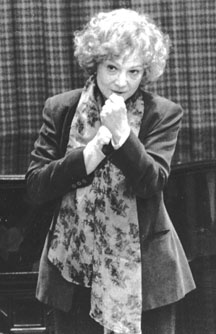
Soprano Teresa Stratas, celebrated Weill aficionado, speaking in Howard Hanson HallAmong festival highlights were concert and opera performances (including the American premiere of some jazz orchestral arrangements of songs originally published in the 1920s), scholarly presentations, exhibits, and a competition for singers. Special guest Teresa Stratas, the Canadian soprano and celebrated Weill aficionado, received an honorary doctorate.
The manuscript collection, on extended loan from Weill's Viennese publisher, Universal Edition A.G., includes such handwritten works as the scores for Three Penny Opera (containing the memorable "Mack the Knife") and The Rise and Fall of Mahagonny.
"These are working manuscripts," says Mary Wallace Davidson, Sibley Library head. "They were used by conductors and were marked up, in one case--I think the conductor was Leonard Bernstein--in red crayon. These scores were snitched, used, and returned. They're worn and battered."
The availability of these materials in an academic music library is enabling editors and scholars to finish work on the forthcoming Kurt Weill Edition, a critical collection of the complete works of the composer.
Notes musicologist and Weill scholar Kim Kowalke, "Eastman has become one of the leading centers for Weill research in the world."
(Photo by Lou Ouzer.)
UNIVERSITY PLAYS ROLE IN DEVELOPING SPECIAL VAN GOGH LIGHTING
The popular Van Gogh exhibit at the National Gallery in Washington last winter owed much to the University's Memorial Art Gallery and to engineering alumnus Kevin McGuire '83.
McGuire, president of Tailored Lighting Inc., developed a new type of bulb that allows art to be bathed in "daylight" while allowing curators to maintain a low intensity of the light to keep damaging ultraviolet radiation to a minimum.
Part of the reason for this success in bringing daylight conditions indoors has been research, led by Steven Weintraub of Art Preservation Services in New York City, showing that under low-light conditions, the eye perceives "daylight" at a slightly different color temperature (more yellow/orange) than under intense outdoor conditions. This means that to illuminate artwork most effectively, scientists need to "tune" the light in museums to a slightly different wavelength than has been traditionally used.
The Memorial Art Gallery was the first to try the new SoLux bulb, laying the groundwork for its use at the Van Gogh exhibit. Another University participant was the Center for Electronic Imaging Systems, which contributed market research.
In Brief
- Holmes named to peace chair: Robert Holmes, professor of philosophy, has been appointed to the newly established Rajiv Gandhi Chair in Peace and Disarmament at Jawaharlal Nehru University in New Delhi, India.
An expert on issues of peace and nonviolence, Holmes has been invited to address numerous conferences in Europe, the Middle East, the United States, and Canada, and participated in the first conference on nonviolence ever held in the former Soviet Union. He continues as a professor at Rochester while occupying the Gandhi chair.
- More rankings: Rochester programs continue to show up in rankings of top-level institutions. Among the latest:
An analysis of political science departments across the country published in the journal PS ranks Rochester third (behind California Institute of Technology and SUNY at Stony Brook) in "research performance" as measured by publications in the most highly regarded professional journals.
The London Financial Times ranked the Simon School in 21st place in a 1999 listing of the top 50 graduate business schools in North America and Europe. In addition to the overall ranking, the school was rated 13th in an "M.B.A. course" sub-ranking.
In its annual ranking of top graduate and professional programs in selected areas (not all disciplines are covered in any one year), U.S. News & World Report cited University programs in physics, medicine, business, and engineering. The College's Ph.D. physics program in the "atomic/molecular" specialty was listed 7th. The School of Medicine and Dentistry was ranked 30th overall among medical schools, and its primary care program was ranked 11th best among primary care medical schools. The School of Engineering and Applied Sciences was ranked 50th. The William E. Simon Graduate School of Business Administration was ranked 23rd.
- Eastman School, RPO team up in new program: Eastman and the Rochester Philharmonic Orchestra are partners in a new program that broadens performing opportunities for top young musicians while adding ranks to the RPO's player roster. Graduate students who qualify as Orchestral Fellows will play in select concerts with the Philharmonic, gaining professional experience. They will also learn about the administrative challenges that professional orchestras face in building audiences and attracting financial support at the end of this century.
For the RPO, the program will put additional "musician-power" in areas where it's needed most--in the string section and in administrative offices.
- Computer ResNet reaches 2,000th user: The University's Computer Center, in conjunction with the Office of Residential Life, has connected its 2,000th user to the ResNet system. ResNet, a campuswide computer network to residence halls, offers quick connection to the Internet and other applications.
The 2,000th user represents two-thirds of all potential ResNet customers on campus. ResNet was activated in 1996.
"We had chosen the number 2,000 as a goal for the end of the year, and we're pleased to have reached it so quickly," said Lisa Brown, ResNet manager. She said reaching that total "keeps us on track with other major universities."
The 2,000th user, Chad Kreiley, a senior from Dansville, New York, signed on at the beginning of the fall semester. A political science major, Kreiley said he uses ResNet to access course material and to keep in touch with friends by electronic mail.

ROCHESTER SCIENCE ONLINE
To receive regular updates on research developments in science, medicine, and engineering at the University, you can subscribe to ScienceCache. Every two or three weeks subscribers receive a synopsis of the latest news in these areas, with pointers to the Web for more information.
To subscribe, send a message with the words "subscribe sciencecache" in the body of the note to majordomo@listener.uis.rochester.edu.
BLAKE GOES ONLINE
A Web site co-edited by Morris Eaves, professor of English, is allowing the world to see and study the work of William Blake as it was originally printed, making it one of the few stops on the Internet that sustain this level of serious research.
The Blake Archive combines the 18th-century painter/poet's text and images, obtained from sources throughout the world, into a marvel of online technology.
The site (http://jefferson.village.virginia.edu/blake/) integrates editions, catalogs, databases, and scholarly tools into an archive that is fully searchable--and not just by texts, but by images as well.
Enhanced by custom-designed programming, the archive allows the user to call up multiple screens, enlarge images, and obtain both descriptions of images and transcriptions of the sometimes hard-to-read original text.
In the first phase of the project, the editors designed the site and loaded Blake's 19 illuminated books from eight major American and British collections, exercising exhaustive quality control on each image. During the second phase they'll add a full range of drawings, paintings, prints, manuscripts, and typographical works.
Kevin Parker, dean of engineering, and two engineering graduate students have signed on to the project as well, researching compression systems used to reduce the size of image files.
The archive site is located at the Institute for Advanced Technology in the Humanities at the University of Virginia, which has been the base of research and development since the beginning. Working with Eaves are Robert Essick of the University of California, Riverside, and Joseph Viscomi of the University of North Carolina at Chapel Hill.
Their work has earned attention in such publications as The Atlanta Journal that includes a review in Choice magazine which declared, "The most important contribution of this truly awe-inspiring effort is the wonderful quality and fidelity of the images. . . . The William Blake Archive goes further toward successful technological simulation of the aesthetic experience than any Web site thus far."
With the nearly prohibitive costs of making traditional print reproductions, "the future of scholarly editing is in electronics," says Eaves, and the Blake Archive is considered a prototype for other visual/textual projects in the humanities.
(Photo from the William Blake Archive, used by permission.)
'PORTAL KOMBAT' FOUND ESSENTIAL FOR ECONOMIC SURVIVAL OF THE WEB
Almost anyone can set up a World Wide Web site these days.
The critical issue is, How do you induce users to hit your site? Without traffic, a site is as good as a billboard in a basement.
This critical Internet marketing problem is addressed in a new study released by three Simon School professors.
The researchers observe that, despite rapid growth of the World Wide Web to several hundred million sites, a select few will continue to attract the majority of visitors and advertising revenue, becoming gatekeepers to the information that is accessed. As competition between these Web giants heats up, the study predicts an increased focus on finding creative ways to funnel traffic and profit from it.
Titled "Portal Kombat: The Battle Between Web Pages to Become the Point of Entry to the World Wide Web," the study is the work of Rajiv Dewan, Marshall Freimer, and Abraham Seidmann. It uses economic models to track the emergence of mega-sites, or portals, on the Web.
"The development of large portals is to be expected as technology changes and the medium matures," says Dewan. "Competition between these sites to serve as an entryway to the Web will increase both specialization and the power these sites have over the Web's smaller inhabitants."
According to Dewan, this phenomenon is similar to that of mega-superstores, like Wal-Mart and Kmart, that lead the retail industry. The small number of dominating portals is not a matter of companies not understanding or not fully utilizing the Web, but a natural progression.
"Economically, it would be impossible for the Web to survive in a marketplace of equal-sized stores," says Dewan. "They would compete too much with themselves--differentiation and specialization are the keys to survival."
According to the study, portals will grow to serve as decision-making gatekeepers to the Web--deciding everything from how users search for information to what sites they visit.
The researchers note that portals endorse smaller sites by deeming them worthy of a link on their page. This creates traffic for the smaller entity while helping the portal to position itself as a gateway to valuable information. "It's a two-way street," Dewan says. "Portals control where users go, but rely heavily on boutique sites for the information that will keep them competitive."
TEACHING DOCTORS TO LISTEN
Twenty-three seconds.
That's the amount of time that doctors, on average, allow their patients to describe their health concerns before they start interrupting.
So say University faculty members Ronald Epstein and Howard Beckman of the Department of Family Medicine at Highland Hospital, in a report published in the Journal of the American Medical Association.
Typically only about a quarter of patients get the chance to fully explain their problems. In a similar study conducted in 1984, Beckman and Richard Frankel, director of the Primary Care Institute at Highland, found that doctors tended to redirect conversations in an average of 18 seconds, frequently choosing a specific point to explore before finding out if the patient had other matters to bring up.
In an intensive course at the medical school, Epstein teaches students how to better relate to patients so that their concerns are properly addressed and acted upon.
The study findings show that physicians specially trained in patient relationships were 44 percent more likely than their fellows to allow patients to finish explaining their points of concern.
Student Discovery Tells of Arctic Warming
Talk about your global warming!Although last year may have been the hottest in recorded history, a team of Rochester students and their professor, geophysicist John Tarduno, have found evidence that 1998's unseasonably torrid temperatures were positively chilly in comparison to those of some 90 million years ago.
According to fossil evidence discovered by the Rochester team and reported in the December 18, 1998, issue of Science, the Earth's Arctic regions were once as tropical as present-day Florida.
The warm-up followed a period of worldwide volcanism that spewed enormous amounts of carbon dioxide into the atmosphere.
The crux of the global-warming evidence: the discovery in the high Canadian Arctic of bones belonging to an eight-foot champsosaur, a now-extinct crocodile-like animal with a long snout and razor-sharp teeth.
The reptiles, which were tied to their fresh-water environment on Axel Heiberg Island in the Arctic archipelago, needed an extended warm period each summer to survive and reproduce. Based on the numbers and sizes of the animals found, researchers estimate that the annual mean temperature in the Arctic during the late Cretaceous period--from roughly 92 million to 86 million years ago--was about 57 degrees Fahrenheit. That means it was rarely if ever freezing during the winter, and summer temperatures consistently reached into the 80s and 90s.
Tarduno's student investigators (six undergraduates and one graduate student) uncovered the first bones during the summer of 1996 on an expedition to a rocky, mountainous Arctic region, seldom if ever before visited by humans. Driven off by heavy rain and snow, the team returned the following year to complete the excavation. Spending six weeks on site during each expedition, the students traipsed through knee-deep snow by day and huddled in nylon tents flapping in strong winds by night. (They dubbed their tent city, just 700 miles from the North Pole, "The Polar Hotel.")
The bones they recovered came from a layer of sediment directly above 1,000 feet of hardened volcanic lava, known as basalt, and just below a layer of marine rock common in the Arctic. That dates the fossils to a time immediately following the volcanic period.
"I had been looking for rocks from this layer for many years, but in most places the layer either doesn't exist or has worn away," says Tarduno, a specialist in the Earth's magnetic field.
"We were walking along a ridge, and we spotted a layer between the brown volcanic rocks and the black marine shale. From a distance we knew that these rocks represented an environment that we hadn't seen before. Once we reached them, we realized that these were fine-grain sedimentary rocks ideal for preservation of fossils. I bet the students that we'd find some.
"Within five minutes one of them pulled up a femur and said, 'Like this?'
"The bone was clearly a vertebrate fossil. Our guess was a large reptile, which would have required a relatively warm climate to survive.
"It was one of those rare instances where you know immediately that what you're looking at has tremendous importance."
CLEAREST IMAGES OF THE RETINA REVEAL REMARKABLE RANDOMNESS
In a paper in the February 11 issue of the journal Nature, a team of University scientists has published the best images ever obtained of the living human retina.
The photos differentiate between the three types of cone cells in the retina, and show an unexpected randomness in their placement.
"We've known for 200 years that there are three types of cones in the human eye, but no one before has been able to see how they're arranged," says first author Austin Roorda, who did the work as a postdoctoral researcher at Rochester and is now on the faculty at the University of Houston.
The findings were made possible thanks to a laser-based system developed by David Williams and colleagues over the last decade that maps out the topography of the inner eye in exquisite detail.
The team built on technology known as adaptive optics, initially proposed by astronomer H. W. Babcock in 1953, and later developed by the U.S. military to clear up images from spy satellites.
Williams, director of the Center for Visual Science, leads an effort to apply the same technology to human vision.
"This random arrangement is not at all what we expected," says Williams. "If you were to design a digital camera, you'd never choose a random geometry like this. Yet it turns out that that's what the most sophisticated imaging device in the world--the human eye--uses."
BRAINS OF THE DEAF MAY REWIRE THEMSELVES TO 'HEAR' WHEN LIP-READING
By capturing stunning images of the human brain at work, researchers have provided new evidence that the brains of deaf people may "rewire" themselves in a manner that may help them communicate with hearing people. The researchers found that a part of the brain normally responsible for hearing and speech--once thought to be relatively inactive in people who are deaf--is actually bustling with activity as deaf people read lips.
"When a person is born deaf, the brain is able to wire itself to make sure that the parts usually used for hearing are reassigned to more useful roles," says Dean K. Shibata of the Department of Radiology.
"This study shows that this reconfiguration is very specific. A visual task involving shape identification does not activate these 'auditory' areas, but tasks involving movement and language, such as lip-reading, do."
WHAT DO HIGH SCHOOLERS KNOW ABOUT POLITICS?
A new book about civic education by Rochester political scientist Richard Niemi and co-author Jane Junn of Rutgers University finds mixed results in what high school students know about politics.
"There is some subject matter that students know a good deal about, along with aspects they know little about," Niemi says.
When studying the U.S. political system, for instance, students demonstrate a competent grasp of national and local politics--or at least they recognize which form of government does what, Niemi and Junn found. On the topic of individual rights particularly, students are well informed.
But high school students know very little about political parties and lobbying. And they are less informed when political issues touch on questions of race and gender.
The new book, Civic Education: What Makes Students Learn, documents how much students know about a wide range of political and civic topics, and also demonstrates differences in civic knowledge when students are grouped by race, gender, and other factors.
The book also explains the cognitive process by which students learn about politics. The authors emphasize that, contrary to a belief widely held in some quarters, civics and government classes do play an important role in teaching about the subject.
A long-standing interest of Niemi's is how and what young people learn about politics. "We need to give students a good deal of knowledge, including what politics is really like," he says. "Students should know how it operates and they need to know that they should be a part of it.
"There's a lot of evidence that citizens, especially young ones, are participating less in politics than they did in the past, and are more indifferent to it.
"We need people who are able and willing to participate in politics because they know why politics exists."
NOVEL MATERIAL
FOR DISPLAY EATS LESS ENERGYThat giant sucking sound coming from your desktop is the computer screen drawing twice as much energy as it should to create a crisp image.
University scientists are out to change that, unveiling a new class of optical materials that efficiently creates the kind of light prized by manufacturers
of displays for computers, televisions, and entertainment systems.The new materials are liquid crystalline glasses that emit nearly perfect circularly polarized light --the kind necessary to create 3-D displays and striking color images--that is hundreds of times more pure than light produced with today's materials.
To obtain such perfectly polarized light, displays routinely strip away more than half of the light they produce. "It's the voracious nature of the display drawing on the battery that makes laptops and cell phones so power-hungry," says scientist Ansgar Schmid, who took part in the research.
"Half of the light must be thrown away. This is not an esoteric problem; it's something millions of people confront every day."
The team is led by Shaw H. Chen, professor of chemical engineering and materials science and senior scientist at the Laboratory for Laser Energetics.
HELPING CHILDREN AND PARENTS COPE WITH CRITICAL ILLNESS
Working as a pediatric intensive care nurse at Children's Hospital in Pittsburgh in the 1980s, Bernadette Melnyk '92N (PhD) was impressed by how well the nurses and doctors knew the technical side of treating critically ill and injured children.
But Melnyk, now an associate professor at Rochester's School of Nursing, also noticed that the staff was too often poorly prepared to help children and parents deal with the emotional trauma that comes with a life-threatening illness.
"As children start to recover from critical illnesses, they start to display new and different emotions and behaviors that their parents are not prepared for," Melnyk says. "The parents feel very anxious and helpless about what they can do to help their children adjust."
Out of that helplessness, Melnyk, who also holds an appointment in pediatrics, found her nursing and scholarly calling. Together with colleague Linda Alpert-Gillis, she has developed a series of intervention programs called "Creating Opportunities for Parent Empowerment" (acronymed COPE). They are designed to help families understand and address the emotional consequences of critical illness and other stressful junctures in life.
Melnyk's original COPE study showed that mothers and children who went through the program reported considerably less anxiety, fewer negative feelings, and fewer symptoms of post-traumatic stress than those who didn't participate.
The program is being studied throughout the United States, as well as in Canada, Israel, and Thailand.
Melnyk and Alpert-Gillis have now developed a similar program for mothers and their children affected by divorce and marital problems. And this past year, they completed a pilot study for a COPE program for mothers with low birth-weight babies in the neonatal intensive care unit.
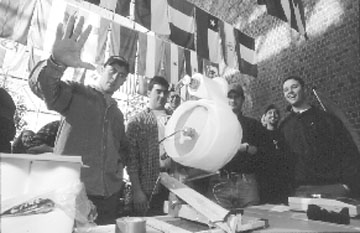
Roll models: How many mechanical engineers does it take to wind a roll of toilet paper? Well, in this instance the answer is three: Seniors Jeff Lang, Brett Mosher, and Marco Lorenzana (left, center, and far right), who are here cheering on the automatic rolling system they concocted for Engineering Week's 1999 TP Bowl.This year's version of the "egg smash" competitions of years past, the TP Bowl required students to use devices of their own design and construction to unwind and rewind an entire roll of toilet paper as quickly and efficiently (no tearing) as possible--all within a one-minute time limit. Obviously on a roll that day, the Lang-Mosher-Lorenzana team placed among the winners in the match, copping second place among the 17 entrants.

- The Tonight Show with Jay Leno: "Scientists at the University of Rochester say they have proven that snakes have the ability to learn. I think we all knew that. That's why we have law schools, pretty much" --Jay Leno, on learning of neuroscientist David Holtzman's work with corn snakes that shows they are not the mental midgets they have popularly been assumed to be.
- Christian Science Monitor: "Talented children should never be put in the position where they are being shown off or exploited. Every performance they give should be something he or she gains from, whether it be a financial return or an important step for their career"--Eastman professor Charles Castleman, in a story on raising children who have extraordinary athletic and performing talents.
- USA Today: "I can't fathom that kind of dollars in terms of what it would mean in lifestyle. In my view, as an owner of a company that creates value, he's entitled to it"--Simon economics professor James Brickley, commenting on reports that Microsoft chairman Bill Gates is worth about $81.4 billion when the value of his stock is calculated.
- Raleigh, N.C., News and Observer: "The soul exists in a form that is changing--a body, a mind. But the soul is an essential, unchanging reality that abides in all things. When we see our real identity it is the same as God's"--Religion professor Douglas Brooks commenting in a column on "What is the soul and does it die?"
- Reuters News Service: "Each of us starts as a single cell encoded with the information to guide our growth into a larger structure--a complete human being"--Samson Jenekhe, professor of chemical engineering, commenting on his laboratory's discovery of plastic molecules that organize themselves into useful and beautiful shapes.
- Chicago Tribune: "We need to put to rest the widespread belief that only children can learn music--that if you didn't learn music as a kid, you missed your chance"--Eastman professor Roy Ernst, in a story on the creation of the New Horizons Band for amateur musicians older than 50, a concept that has spread from the Eastman School to 40 such ensembles across the country.
"Though the amateur bands have yet to uncover any prodigies," the article continues, "teachers find that seniors pick up musical skills at least as fast as average kids, if not faster. They come motivated and don't have to deal with parental pressure."
- The New York Times: "Suddenly, the scene comes alive with the echo of plainsong"--A Times reporter commenting on archeological historian David Walsh's description of his solution to a medieval architectural mystery: the appearance and location of the choir screen in the long-destroyed 12th-century Abbey of Cluny in Burgundy.
- Time: "While [baseball] radiates a spiritual transcendence, it also expresses a parallel paradoxical quality of sadness . . . it instructs us in two crucial American concepts, the loneliness of space and the sadness of time"--English professor George Grella, quoted by columnist Lance Morrow in an essay suggesting that football needs a fancier mystique like baseball's.

HOME RUN HITTER
Before Mark McGwire and Sammy Sosa began their home run derby last summer, the University had its own long-ball record setter.
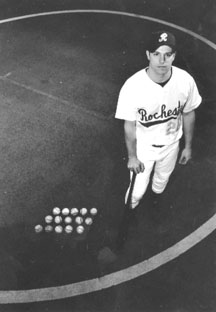
Bobby VersacciBobby Versacci '99 broke the single-season record for home runs by belting 15 in the spring of 1998, helping the Yellowjackets capture the Eastern Collegiate Athletic Conference (ECAC) Upstate New York title.
As the spring 1999 season got under way in March, Versacci needed 10 more homers to break the career record held by Tom Havens '91.
The health and society major from Ossining, New York, says the career record would be nice, but he has his eyes on the Division III NCAA World Series.
"If it happens, it happens," Versacci says of the record. "I won't be too disappointed if I don't break it as long as we reach the team's goal of playing in the World Series."
Versacci, a left-handed hitter known for his remarkable bat speed, credits his teammates, particularly pitchers Chris LaRocco '99 and Aaron Jacyna '98, and coach Bob Hartz '91 for the Yellowjackets' recent success.
"The team's enthusiasm throughout the season and the chemistry that we have had has been excellent," he says. "Our team is talented enough and good enough to go to the next level."
Versacci tied Havens's single-season record of 12 with a homer against St. Lawrence late in the 1998 regular season.
He hit three more during the two-game ECAC tournament to set the record and earn him the tournament MVP award.
He also broke the Yellowjacket record for runs scored in a season with 50, finishing the season with a .386 average and 37 RBIs.
Versacci was named First Team All-Region by the American Baseball Coaches Association, First Team All-ECAC, and Upstate Collegiate Athletic Association Player of the Year for 1998.
FALL WRAP-UP
Jessica Svatek '99 and Aria Garsys '00 earned individual honors for their accomplishments in the fall 1998 athletic season.
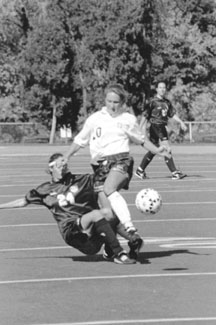
Garsys: All-AmericanSvatek was named Second Team GTE College Division Academic All-America for women's volleyball. Garsys was named Second Team All-America in women's soccer as selected by the National Soccer Coaches Association of America.
Both women continued traditions in their respective sports. Svatek, who has a 3.94 GPA in biomedical engineering, is the fourth women's volleyball player to earn national Academic All-America honors. It also marks the third consecutive year that a Rochester athlete has received the volleyball honor.
Garsys is the 21st women's soccer player to earn All-America acclaim since 1981. She also was named as the New York State Player of the Year.
Statistically, Svatek led the Yellowjackets in kills (391), hitting percentage (.277), and digs (417). She was named to four all-tournament teams and chosen First Team All-Upstate Collegiate Athletic Association. Rochester finished second at the UCAA championships, 12-30 overall.
Garsys moved to striker and responded with a team-high 10 goals and three assists for 23 points. She helped Rochester reach the second round of the NCAA Division III playoffs (beating Nazareth, 1-0, in 3 OTs, losing on penalty kicks to William Smith). The Yellowjackets finished 13-4-3, ranked as the 19th best team in Division III.
- Football: Under first-year head coach Mark Kreydt '88, the Yellowjackets capped off their season with a 26-21 victory over Union College in the season finale (1-8). The Rochester victory kept Union out of post-season play and came six years to the day (November 7) that Union upended Rochester, 14-10, at Fauver to deny the Yellowjackets an NCAA bid.
- Men's Soccer: A young Yellowjacket team got it in gear in the second half of the season, notching three wins and four ties in the last 10 games. Rochester finished 3-10-4.
- Field Hockey: Rochester finished the season with a 6-12 overall record, 2-4 in the UCAA. Jessica Anderson '99 had 14 assists to snap the school record of 12, held by Amy Deep '90. Anderson and Melissa Glendening '99 were named All-State. Three players earned Academic honors from the National Field Hockey Coaches Association.
- Men's Cross Country: New head coach Dick MacKenzie guided the Yellowjackets to a sixth place finish (of 14) at the state championships. Frank Szakaly '02 was the most consistent runner, finishing ninth at UAAs to earn Second Team All-UAA honors, and fifth at the state run, to earn All-New York State acclaim.
- Women's Cross Country: The Yellowjackets claimed the team trophy at the Alfred Invitational, finished third at UCAAs, and fourth at New York States. Jodi House '00 and Laurie Kurtelawicz '99 earned All-UCAA acclaim.
- Women's Tennis: Jill Mazza '01 defeated the third-ranked and 11th-ranked players in Division III on her way to the Rolex Small College championships in Tennessee. (She lost in the final.) Rochester was 6-1 in dual matches and finished second at New York States for the third straight year.
- Golf: The Yellowjackets finished in the top half of the pack three times in six outings, including a ninth-place finish (of 20) at the ECAC qualifier, sixth at both Allegheny's Guy Kuhn Invitational and the Western Maryland Invitational (13 schools competed at each one).
- Men's Tennis: Rochester won the Flower City Tournament, then made a strong showing in the ITA/Rolex Northeast Regional Championships at Vassar. Karan Raichand '99 reached the Rolex semifinals before losing.
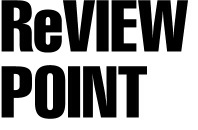
An occasional column of faculty opinion
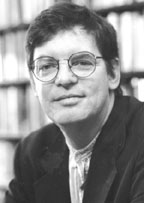
Westbrook World War II Wasn't About the Constitution
By Robert Westbrook
Any doubts one might have about the pivotal place of World War II in the American moral imagination should be laid to rest by the Clinton impeachment trial.
Both the president's prosecutors and his defenders alike have called that war's GIs to the stand in their cause. To hear Henry Hyde and Dale Bumpers tell it, the American soldier who hit the beaches of Normandy and Guadalcanal carried not a photograph of his sweetheart but a copy of the Constitution.
In searching for an ethical compass in the experience of these troops, the politicians are in good company. Recent months have witnessed not only the unabashed pieties of newsman Tom Brokaw's best-selling book about these men of The Greatest Generation, but also two fine movies that center on their struggles: Steven Spielberg's Saving Private Ryan and Terrence Malick's The Thin Red Line.
A good deal of the power of the two movies lies in their willingness to venture into the dark complexities of the GI experience, complexities fully evident in the great memoirs of the war such as E. B. Sledge's With the Old Breed. Neither movie wholly satisfies in this respect.
After its oft-celebrated opening on Omaha Beach, Ryan succumbs to Hollywood war-movie conventions, and Malick fogs up his vivid portrait of the hell of tropical warfare with windy interior monologues and metaphysical mumbo jumbo. Yet both films at least risk a view more complex than the tribute to simple, undaunted patriotism that has resounded in the Senate.
In both films, soldiers are as much victims as heroes, victims not only of the unforgiving power of modern weaponry but of the stupidity and self-serving ambition of those who command their movements. The mission to save Ryan that dooms Tom Hanks's Captain Miller is, as he says, a "public relations" stunt. And the troops commanded by the sensitive Captain Stavros played by Elias Koteas in The Thin Red Line are thrown into a deadly frontal assault on hardened Japanese positions in order to serve the thwarted ambition of their colonel.
Such screwups were not uncommon in the war. Soldiers were at the mercy of the outsized egos of commanders such as Douglas MacArthur and George Patton. American planes bombed American troops in the French countryside. GIs were armed with faulty equipment and pointed toward dubious objectives.
Sledge recounts the bloody campaign on the coral ridges of Peleliu, an island strategists later admitted might well have been bypassed. Officers such as Miller and Stavros were matched by those less endeared to GIs. Such contempt of the "dogfaces" for their supposed betters was nicely captured in the wartime cartoons of Bill Mauldin and Sad Sack's George Baker, which appalled Patton and delighted his men.
Both Spielberg and Malick give us soldiers like Sledge and his comrades for whom the answer to the question of why they must die was hard to come by. Nothing easily answered their fear, and, to his credit, Malick suggests that the same may have been true for the Japanese.
Spielberg's GIs eventually embrace the mission to save Ryan--the sole survivor among an Iowa mother's four boys sent to war--by rendering it emblematic of the private obligations, especially the familial obligations, that most moved American soldiers and civilians during the war. The movie might better have been titled Saving Mrs. Ryan's Son.
Malick, for all his invocations of a "spark" of religious redemption "shining through" the horror, offers no resolute meaning for the war. He gives the most compelling lines to the film's cynics, and he is blessed with a cast of edgy actors--Woody Harrelson, Nick Nolte, Sean Penn--who know how to deliver them.
In The Thin Red Line, the private moved by memories of and private obligations to the girl back home receives a "Dear John" letter. "War doesn't ennoble men," one character remarks. "It turns them into dogs; it poisons the soul."
One need not doubt nor diminish the courage of those who fought in World War II to appreciate the truth and the force of such sentiments. And we would do well to honor those who fought on the battlefields of World War II by resisting the temptation to attribute to them a ready willingness to die for the "rule of law" or Constitutional government. Their sacrifice--as Spielberg and Malick contend--was a good deal more complicated and troubling.
A specialist in modern American history, Robert Westbrook is professor of history and chair of the department in the College.This article first appeared in Newsday's View Point section.
Copyright © 1999 Newsday, Inc. Reprinted by permission.

Maintained by University Public Relations